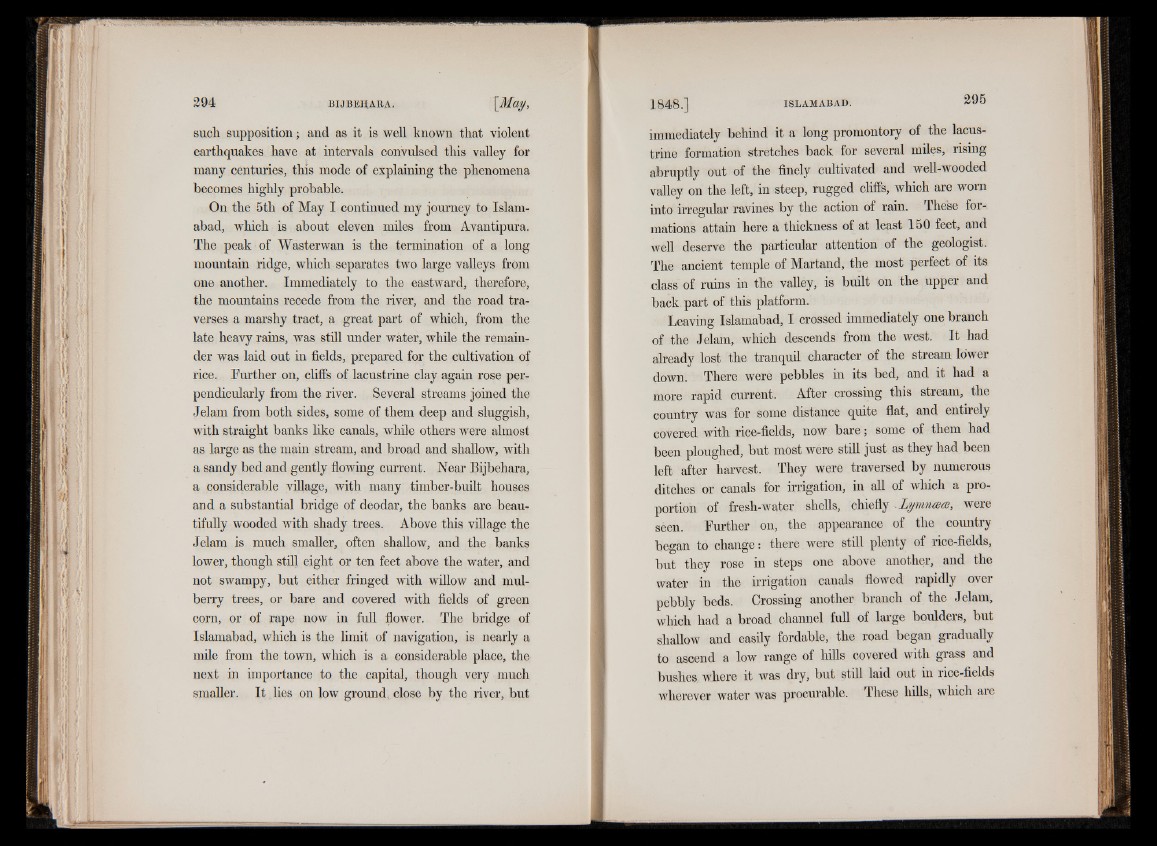
such supposition; and as it is well known that violent
earthquakes have at intervals convulsed this valley for
many centuries, this mode of explaining the phenomena
becomes highly probable.
On the 5th of May I continued my journey to Islamabad,
which is about eleven miles from Avantipura.
The peak of Wasterwan is the termination of a long
mountain ridge, which separates two large valleys from
one another. Immediately to the eastward, therefore,
the mountains recede from the river, and the road traverses
a marshy tract, a great part of which, from the
late heavy rains, was still under water, while the remainder
was laid out in fields, prepared for the cultivation of
rice. Further on, cliffs of lacustrine clay again rose perpendicularly
from the river. Several streams joined the
Jelam from both sides, some of them deep and sluggish,
with straight banks like canals, while others were almost
as large as the main stream, and broad and shallow, with
a sandy bed and gently flowing current. Near Bijbehara,
a considerable village, with many timber-built houses
and a substantial bridge of deodar, the banks are beautifully
wooded with shady trees. Above this village the
Jelam is much smaller, often shallow, and the banks
lower, though still eight or ten feet above the water, and
not swampy, but either fringed with willow and mulberry
trees, or bare and covered with fields of green
corn, or of rape now in full flower. The bridge of
Islamabad, which is the limit of navigation, is nearly a
mile from the town, which is a considerable place, the
next in importance to the capital, though very much
smaller. It lies on low ground, close by the river, but
immediately behind it a long promontory of the lacustrine
formation stretches back for several miles, rising
abruptly out of the finely cultivated and well-wooded
valley on the left, in steep, rugged cliffs, which are worn
into irregular ravines by the action of rain. These formations
attain here a thickness of at least 150 feet, and
well deserve the particular attention of the geologist.
The ancient temple of Martand, the most perfect of its
class of ruins in the valley, is built on the upper and
back part of this platform.
Leaving Islamabad, I crossed immediately one branch
of the Jelam, which descends from the west. It had
already lost the tranquil character of the stream lower
down. There were pebbles in its bed, and it had a
more rapid current. After crossing this stream, the
country was for some distance quite flat, and entirely
covered with nce-fields, now bare; some of them had
been ploughed, but most were still just as they had been
left after harvest. They were traversed by numerous
ditches or canals for irrigation, in all of which a proportion
of fresh-water shells, chiefly Lymn<zai, were
seen. Further on, the appearance of the country
began to change % there were still plenty of rice-fields,
but they rose in steps one above another, and the
water in the irrigation canals flowed rapidly over
pebbly beds. Crossing another branch of the Jelam,
which had a broad channel full of large boulders, but
shallow and easily fordable, the road began gradually
to ascend a low range of hills covered with grass and
bushes, where it was dry, but still laid out in rice-fields
wherever water was procurable. These hills, which are